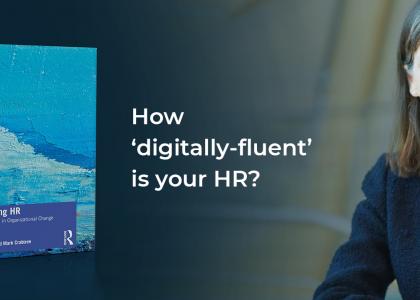The need for digitally fluent HR

In the third of the series of blogs on the role of HR in organisational change, Professor Julie Hodges looks at why HR needs to embrace technology.
External forces, such as the global pandemic and advances in technology are radically evolving the HR landscape. Traditionally, the HR department was responsible for activities such as sourcing and engaging new employees or ensuring the fairness of grievance and disciplinary procedures. This traditional role of HR is being disrupted by forces for change which the function needs to be aware of, and proactively engage with.
Technology provides new opportunities for HR. It enables the transformation of the function and drives greater efficiency and effectiveness. As organisations increasingly automate traditional HR and people management transactional activities such as administration, payroll and recruitment, HR is becoming largely redundant in basic transactional processes. Furthermore, technology can help HR to take a more holistic approach to simplifying workforce management through the use of workforce shaping; finding, developing and retaining the right talent; predicting workforce changes and issues; planning in alignment with organisational goals and working strategically with senior executives.
Its effectiveness depends on designing, implementing and using it to meet an organisation’s specific needs and doing so requires a close relationship between HR and IT. To engage in that relationship, HR will need to have a solid grasp of the possibilities and limitations of technology and be active participants in looking for opportunities to leverage it.
HR will need to be digitally fluent since technology is dramatically increasing the flow of data and information that is available which includes internal information about employees and their skills and competencies, and external information about competitors’ employees and the talent marketplace. Moreover, the development of analytics is disrupting HR, particularly predictive analytics which anticipate behavioural patterns before they occur. For example, predictive analytics can enable HR to identify which workers are most likely to leave the organization within specific timeframes and create custom retention plans for at-risk talent. HR Professionals need to be comfortable with this type of data, be able to derive insights from it and translate them into interventions to enable optimisation of the workforce. HR, therefore, needs to be able to maximise the power of data to generate predictive and actionable insights for the organisation in order to drive better decision-making.
Technology is therefore disrupting the status quo but also opening up new possibilities for HR. On the one hand, HR can use technology to provide the organisation with insights from data analytics and visualisation that enable decisions to be made which drive results. However, on the other hand, technology is not a panacea and its effectiveness depends on designing, implementing and using it to meet an organisation’s specific needs, which requires a close relationship between HR and technology. To engage in that transition HR must have a solid grasp of the possibilities and limitations of technology and be an active participant in looking for opportunities to leverage it. In addition, the increasing use of technology requires HR to be instrumental in developing the digital literacy of the workforce.
This is the third in a series of four blogs on the role of HR in organisational change, which is the subject of Professor Hodges’ new book: Reshaping HR: the role of HR in Organizational Change. To celebrate, we’re giving away five copies of Professor Hodges’ book. To be in with a chance of winning, just share this blog across your social channels, tagging @Mhr into your post.

